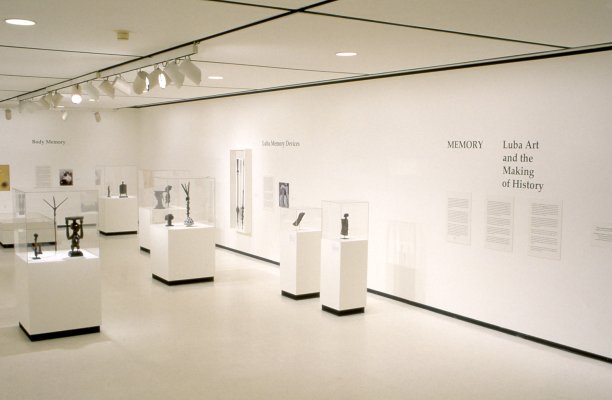Memory: Luba Art and the Making of History
Saturday, July 26, 1997–Sunday, October 5, 1997

Installation view of Memory: Luba Art and the Making of History. Photograph by Tom Loonan.
1905 Building
Memory: Luba Art and the Making of History was the first exhibition to present the art and culture of the Luba people of Zaire (recently renamed Congo) to the American public. In the absence of writing, the Luba people used complex beautifully sculpted royal regalia and other visual devices to elicit memory, making this the first ever exhibition to explore how works of art function in the reconstruction of memory and the making of history. Organized by the Museum for African Art in New York, this exhibition was also presented at the National Museum of African Art of the Smithsonian Institution, Washington, D.C.
The Luba people, who comprised one of the most important kingdoms of central Africa from the 17th to the 19th centuries, highly valued the recollection of history. In that regard, they produced a large body of art objects intended to stimulate and guide memory. This exhibition was composed of more than 100 of these objects dating from the 18th to the 20th centuries, including memory boards, beaded emblems, wooden stools, baskets, staffs, figures, divination objects, and works in metal. These art forms once belonged to Luba kings, chiefs, titleholders, diviners, and association members to affirm their royal status and to enable remembrance and reinterpretation of their past. They are used even today for purposes of problem solving and political rationale.
The exhibition was organized around seven areas of Luba cultural experience: kings, women, families, associations, diviners, chiefs, and artists. The works associated with these domains and the information elicited by them demonstrated that there is no single history or experience for the Luba, but rather, multiple histories. The Luba believed that the memory devices ensure that memory is an active, dynamic process, and that history is always in the making, helping people to understand and cope with their changing circumstances.
Memory was accompanied by a richly illustrated catalogue of the same name, published jointly by the Museum for African Art and Prestel, Munich. The book is co-edited and co-authored by Dr. Mary Nooter Roberts and Dr. Allen F. Roberts, Africanist and anthropologist at the University of Iowa.
This exhibition was organized by The Museum for African Art, New York.